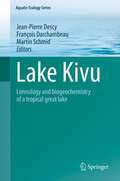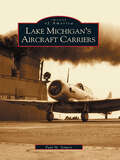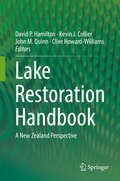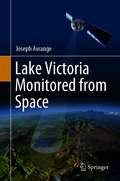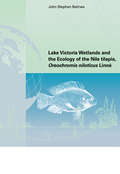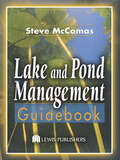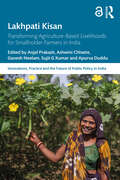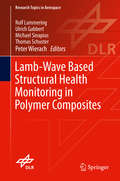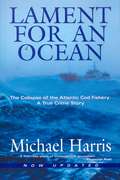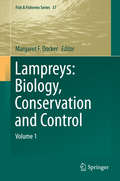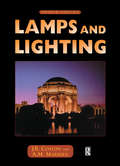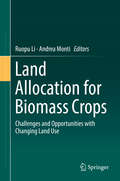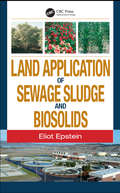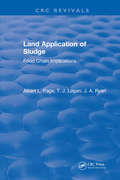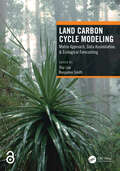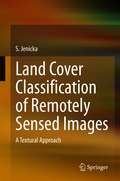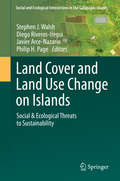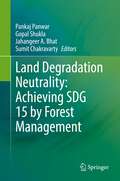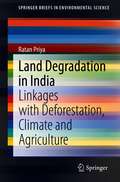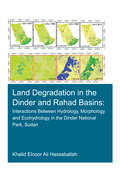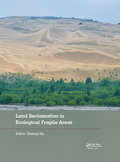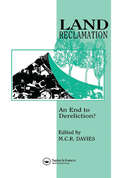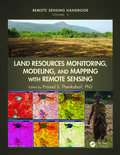- Table View
- List View
Lake Kivu
by Jean-Pierre Descy Martin Schmid François DarchambeauIn the heart of Africa, a unique lake attracts the attention of scientists since the beginning of the 20th century. At the foot of the Virunga volcano chain, Lake Kivu harbors a vast amount of dissolved carbon dioxide and methane, making this lake the most dangerous lake on Earth. But the lake furnishes also many goods and services for surrounding populations and may soon become the most important energy supplier in the area. At the beginning of gas exploitation, the time has come for gathering the large amount of scientific information acquired during past and present research on Lake Kivu. The eleven chapters cover many aspects of the physics, geochemistry and biology of the lake, with a particular focus on the unique physical and geochemical features of the water column and on the ecological functioning of the surface waters. The impacts of the introduced fish species and the potential impacts of methane exploitation are also summarized. This multi-disciplinary book may also be used as an introduction to the limnology and biogeochemistry of large tropical lakes, as it covers various aspects of the physics, geochemistry, biology and ecology of the African Great Rift lakes.
Lake Michigan's Aircraft Carriers (Images of America)
by Paul M. SomersLake Michigan's Aircraft Carriers is the story of the USS Wolverine and the USS Sable, two Great Lakes excursion ships converted for use as aircraft carrier training during World War II. Through the duration of the war, the United States Navy qualified 17,800 pilots for aircraft carrier operation. Training the pilots on either the Atlantic or the Pacific Ocean would have exposed the training ships to the danger of submarine attack, while requiring the escort of fighting ships that were needed elsewhere. It would also have involved arming and armoring the ships used for training. Commander R.F. Whitehead came up with an idea that solved all of these problems. He suggested doing the training on the protected waters of the Great Lakes.The USS Wolverine and the USS Sable were chosen and thus became the only fresh water, paddle-wheeled, coal-fired aircraft carriers in the history of the world. Author Paul M. Somers shares his collection of vintage photos and a lifetime of research to detail the history of these two great vessels-from their life as cruise ships to their contributions to the war effort and then to their eventual scrapping.
Lake Restoration Handbook: A New Zealand Perspective
by David P. Hamilton Kevin J. Collier John M. Quinn Clive Howard-WilliamsLakes across the globe require help. The Lake Restoration Handbook: A New Zealand Perspective addresses this need through a series of chapters that draw on recent advances in modelling and monitoring tools, citizen science and First Peoples’ roles, catchment and lake-focused restoration techniques, and policy implementation. New Zealand lakes, like lakes across the globe, are subject to multiple pressures that have increased in severity and scale as land use has intensified, invasive species have spread and global climate change becomes manifest. This books builds on the popular Lake Managers Handbook (1987), which provided guidance on undertaking investigations into, and understanding lake ecosystems in New Zealand. The Lake Restoration Handbook: A New Zealand Perspective synthesises contemporary issues related to lake restoration and rehabilitation, integrated with social science and cultural viewpoints, and complemented by authoritative topic-area summaries by renowned scientists and practitioners from across the globe. The book examines the progress of lake restoration and the new and emerging tools available to managers for predicting and effecting change. The book will be a valuable resource for natural and social scientists, policy writers, lake managers, and anyone interested in the health of lake ecosystems.
Lake Victoria Monitored from Space
by Joseph AwangeThis book employs a suite of remotely sensed products and advanced technologies to provide the first comprehensive space-based sensing of Lake Victoria, the world’s second largest freshwater lake that supports a livelihood of more than 42 million people, modulates regional climate, but faces myriads of challenges. Proper understanding of the lake and changes in its physical dynamics (e.g., water level, shorelines and areal dynamics) resulting from the impacts of climate variation and climate change as well as anthropogenic (e.g., hydropower and irrigation) is important for its management as well as for strategic development before, during and after climate extremes (e.g., floods and droughts) in order to inform policy formulations, planning and mitigation measures. Owing to its sheer size, and lack of research resources commitment by regional governments that hamper its observations, however, it is a daunting task to undertake studies on Lake Victoria relying solely on in-situ “boots on the ground” measurements, which are sparse, missing in most cases, inconsistent or restricted by governmental red tapes. To unlock the potentials of Lake Victoria, this book argues for the removal of obsolete Nile treaties signed between Britain, Egypt and Sudan in the 1920s and 1950s, which prohibits its utilization by the upstream countries. The book is useful to those in water resources management and policy formulations, hydrologists, environmentalists, engineers and researchers.In a unique cross-disciplinary approach, the Book articulates the various climatic impacts and explanations from natural and anthropogenic origins, which affected Lake Victoria and its vicinity, including the drastic increase and depletion of water level in the Lake and dams, floods and droughts, water quality/security, crop health, food security, and economic implications. With no exception as in his many publications, Joseph L. Awange used data analysis methodologies including filtering, adjustment theory, and robust statistics, to quantify the hydrologic and other parameters, and their estimated uncertainties. The Book is recommended for readers from a diverse disciplines, including physical and social sciences, policy, law, engineering, and disaster management. Professor C.K. Shum, Ohio State University.
Lake Victoria Wetlands and the Ecology of the Nile Tilapia
by John Stephen BalirwaThis volume is taken from an ecological study of wetlands undertaken in northern Lake Victoria (East Africa) between 1993 and 1996 with the major aim of characterizing shallow vegetation-dominated interface habitats, and evaluating their importance for fish, in particular, for the Nile tilapia.
Lake and Pond Management Guidebook
by Steve McComasThe Lake and Pond Management Guidebook is the successor to the bestselling Lake Smarts: The First Lake Maintenance Handbook, the "bible" for small-scale lake and pond improvements, published by the Terrene Institute in 1993. Completely revised and updated, now published by Lewis Publishers, this guidebook contains over 300 ideas and projects includ
Lakhpati Kisan: Transforming Agriculture-Based Livelihoods for Smallholder Farmers in India (Public Policy in India)
by Anjal Prakash, Ashwini Chhatre, Ganesh Neelam, Sujit G Kumar and Apurva DudduAgriculture plays an essential role in the growth of developing economies, as agricultural production is key to food security and is closely intertwined with the livelihoods of many. This book explores the lives of smallholder agricultural farmers in India and the dire challenges that agricultural households face.Focussing on the Lakhpati Farmers initiative, the book examines interventions made by the programme to economically empower farmers and accelerate income growth in the agriculture sector. The programme, initiated by the Collectives for Integrated Livelihood Initiatives (CInI) in the tribal belts of central Indian states, helped farmers earn over INR 100,000 (or one lakh – hence Lakhpati) per annum. The programme engaged with households in 12 districts across 4 states – Jharkhand, Odisha, Maharashtra, and Gujarat – to bring about change through economic empowerment and improve the quality of life of tribal communities. This book documents these initiatives and strategies to meet the aspirations of small and marginal farmers by understanding the ingredients, processes, and challenges involved. The book analyses the programme, examines case studies, and offers ways forward.Part of the Innovations, Practice and the Future of Public Policy in India series, this volume will interest students and researchers of agriculture and rural development, business management, governance, public policy, development studies, and sociology.This book is freely available as a downloadable Open Access PDF at http://www.taylorfrancis.com under a Creative Commons (CC-BY-NC-ND) 4.0 license.
Lamb-Wave Based Structural Health Monitoring in Polymer Composites
by Thomas Schuster Michael Sinapius Rolf Lammering Ulrich Gabbert Peter WierachThe book focuses especially on the application of SHM technology to thin walled structural systems made from carbon fiber reinforced plastics. Here, guided elastic waves (Lamb-waves) show an excellent sensitivity to structural damages so that they are in the center of this book. It is divided into 4 sections dealing with analytical, numerical and experimental fundamentals, and subsequently with Lamb-wave propagation in fiber reinforced composites, SHM-systems and signal processing. The book is designed for engineering students as well as for researchers in the field of structural health monitoring and for users of this technology.
Lament for an Ocean: The Collapse of the Atlantic Cod Fishery
by Michael HarrisThe northern cod have been almost wiped out. Once the most plentiful fish on the Grand Banks off the coast of Newfoundland, the cod is now on the brink of extinction, and tens of thousands of people in Atlantic Canada have been left without work by a 1992 moratorium on fishing the stock. Today, the Pacific salmon stocks are in similar trouble – victims of the same blind, stupid greed. Angry, accusatory fingers have been pointed at various possible culprits for the collapse of the cod – at the Spanish and Portuguese, who for hundreds of years sent ever-bigger fleets to the Grand Banks; at the factory-freezer trawlers, which “vacuumed” the ocean floor for the prized fish; at those inshore fishermen who circumvented the rules governing the fishery; at the federal Department of Fisheries and Oceans, which is responsible for managing the fishery; at the harp seal, the cod’s competitor for food, whose numbers have exploded in recent years; even at Nature, for lowering the temperature of the ocean. InLament for an Ocean,the award-winning true-crime writer Michael Harris investigates the real causes of the most wanton destruction of a natural resource in North American history since the buffalo were wiped off the face of the prairies. The story he carefully unfolds is the sorry tale of how, despite the repeated and urgent warnings of ocean scientists, the northern cod was ruthlessly exploited.
Lampreys: Biology, Conservation and Control
by Margaret F. DockerThe book provides the most comprehensive review of lamprey biology since Hardisty and Potter's five-volume "The Biology of Lampreys" published more than 30 years ago. Published in two volumes, it includes contributions from international lamprey experts, reviewing and providing new insights into the evolution, general biology, and management of lampreys worldwide. This first volume offers up-to-date chapters on the systematics, general biology, conservation status, and conservation needs of lampreys. It will serve as an important reference for researchers working on any aspect of lamprey biology and fishery managers whose mandate is to control or conserve lamprey populations.
Lamps and Lighting
by M.A. CaylessThis book is a comprehensive guide to the theory and practice of lighting. Covering the physics of light production, light sources, circuits and a wide variety of lighting applications, it is both suitable as a detailed textbook and as thoroughly practical guide for practising lighting engineers. This fourth edition of Lamps and Lighting has been completely updated with new chapters on the latest lamp technology and applications. The editors ahve called upon a wide range of expertise and as a result many sections have been broadened to include both European and US practice.The book begins with a description of the fundamentals of light, vision, colour and measurement. Part II, the main section of the book, deals with lamps and control equipment and includes descriptions of all lamp types in use today. Part III on lighting covers both interior and exterior applications.
Land Allocation for Biomass Crops: Challenges and Opportunities with Changing Land Use
by Andrea Monti Ruopu LiThis edited volume establishes a forum for international experts to explore cutting-edge questions associated with the land use and biomass production. Topics include ‘do we have enough land, either primary or marginal, to accommodate future production of biomass?’, ‘how are farming decisions made in response to biomass incentives?’, ‘is the current bio-mass production socially, economically and environmentally sustainable?’, and ‘what are the main constraints currently limiting biofuel deployment?’ The expansion of biomass production is often at the cost of reduced land availability for food production and losses of areas with ecological functions such as forests and wetlands. This process often involves complex interplay of physical dynamics and human systems that are driven by numerous geographic and socio-economic factors at different scales. Thus, the state-of-the-art research on the land use issues surrounding the biomass production and its environmental impacts is important for informed land management decision making. This book will be of great use to researchers in land use management and biomass-based renewable energy, as well as practitioners.
Land Application of Biosolids: Process Design Manual
by Protection Agency Us EnvironmentalThis book covers the advantages, limitations and operational standards for common land application of biosolids practices, including uses on agricultural lands, forest lands, reclamation sites, and public and private use sites. It is useful to people in all aspects of the wastewater industry.
Land Application of Sewage Sludge and Biosolids
by Eliot EpsteinOver 50 percent of the 6,900 million dry tons of sewage sludge generated each year in the United States is land applied. The principal controversies surrounding the land application of biosolids involve heavy metals and pathogens. Land Application of Sewage Sludge and Biosolids is a comprehensive, scientific text providing a complete review of vari
Land Application of Sludge
by Albert L. PageThis book is the proceedings of a workshop entitled Effects of Sewage Sludge Quality and Soil Properties on Plant Uptake of Sludge-Applied Trace Constituents, jointly sponsored by the U.S. Environmental Protection Agency, Cincinnati, OH, the University of California at Riverside, and The Ohio State University in Columbus. The meeting was conducted in Las Vegas, NV, November 13-15, 1985, under cooperative agreement CR-812673, and the project officer, representing the Cincinnati EPA‘s Wastewater Engineering Research Laboratory, was J. A. Ryan. This book has been reviewed by the U.S. Environmental Protection Agency and, though it is approved for publication, mention of trade names or commercial products does not constitute endorsement or recommendation for use by either the EPA or by the Publisher.
Land Carbon Cycle Modeling: Matrix Approach, Data Assimilation, & Ecological Forecasting
by Benjamin Smith Yiqi LuoCarbon moves through the atmosphere, through the oceans, onto land, and into ecosystems. This cycling has a large effect on climate – changing geographic patterns of rainfall and the frequency of extreme weather – and is altered as the use of fossil fuels adds carbon to the cycle. The dynamics of this global carbon cycling are largely predicted over broad spatial scales and long periods of time by Earth system models. This book addresses the crucial question of how to assess, evaluate, and estimate the potential impact of the additional carbon to the land carbon cycle. The contributors describe a set of new approaches to land carbon cycle modeling for better exploring ecological questions regarding changes in carbon cycling; employing data assimilation techniques for model improvement; and doing real- or near-time ecological forecasting for decision support. This book strives to balance theoretical considerations, technical details, and applications of ecosystem modeling for research, assessment, and crucial decision making. Key Features Helps readers understand, implement, and criticize land carbon cycle models Offers a new theoretical framework to understand transient dynamics of land carbon cycle Describes a suite of modeling skills – matrix approach to represent land carbon, nitrogen, and phosphorus cycles; data assimilation and machine learning to improve parameterization; and workflow systems to facilitate ecological forecasting Introduces a new set of techniques, such as semi-analytic spin-up (SASU), unified diagnostic system with a 1-3-5 scheme, traceability analysis, and benchmark analysis, for model evaluation and improvement Related Titles Isabel Ferrera, ed. Climate Change and the Oceanic Carbon Cycle: Variables and Consequences (ISBN 978-1-774-63669-5) Lal, R. et al., eds. Soil Processes and the Carbon Cycle (ISBN 978-0-8493-7441-8) Windham-Myers, L., et al., eds. A Blue Carbon Primer: The State of Coastal Wetland Carbon Science, Practice and Policy (ISBN 978-0-367-89352-1)
Land Cover Classification of Remotely Sensed Images: A Textural Approach
by S. JenickaThe book introduces two domains namely Remote Sensing and Digital Image Processing. It discusses remote sensing, texture, classifiers, and procedures for performing the texture-based segmentation and land cover classification. The first chapter discusses the important terminologies in remote sensing, basics of land cover classification, types of remotely sensed images and their characteristics. The second chapter introduces the texture and a detailed literature survey citing papers related to texture analysis and image processing. The third chapter describes basic texture models for gray level images and multivariate texture models for color or remotely sensed images with relevant Matlab source codes. The fourth chapter focuses on texture-based classification and texture-based segmentation. The Matlab source codes for performing supervised texture based segmentation using basic texture models and minimum distance classifier are listed. The fifth chapter describes supervised and unsupervised classifiers. The experimental results obtained using a basic texture model (Uniform Local Binary Pattern) with the classifiers described earlier are discussed through the relevant Matlab source codes. The sixth chapter describes land cover classification procedure using multivariate (statistical and spectral) texture models and minimum distance classifier with Matlab source codes. A few performance metrics are also explained. The seventh chapter explains how texture based segmentation and land cover classification are performed using the hidden Markov model with relevant Matlab source codes. The eighth chapter gives an overview of spatial data analysis and other existing land cover classification methods. The ninth chapter addresses the research issues and challenges associated with land cover classification using textural approaches. This book is useful for undergraduates in Computer Science and Civil Engineering and postgraduates who plan to do research or project work in digital image processing. The book can serve as a guide to those who narrow down their research to processing remotely sensed images. It addresses a wide range of texture models and classifiers. The book not only guides but aids the reader in implementing the concepts through the Matlab source codes listed. In short, the book will be a valuable resource for growing academicians to gain expertise in their area of specialization and students who aim at gaining in-depth knowledge through practical implementations. The exercises given under texture based segmentation (excluding land cover classification exercises) can serve as lab exercises for the undergraduate students who learn texture based image processing.
Land Cover and Land Use Change on Islands: Social & Ecological Threats to Sustainability (Social and Ecological Interactions in the Galapagos Islands)
by Stephen J. Walsh Philip H. Page Diego Riveros-Iregui Javier Arce-NazarioGlobalization is not a new phenomenon, but it is posing new challenges to humans and natural ecosystems in the 21st century. From climate change to increasingly mobile human populations to the global economy, the relationship between humans and their environment is being modified in ways that will have long-term impacts on ecological health, biodiversity, ecosystem goods and services, population vulnerability, and sustainability. These changes and challenges are perhaps nowhere more evident than in island ecosystems. Buffeted by rising ocean temperatures, extreme weather events, sea-level rise, climate change, tourism, population migration, invasive species, and resource limitations, islands represent both the greatest vulnerability to globalization and also the greatest scientific opportunity to study the significance of global changes on ecosystem processes, human-environment interactions, conservation, environmental policy, and island sustainability.In this book, we study islands through the lens of Land Cover/Land Use Change (LCLUC) and the multi-scale and multi-thematic drivers of change. In addition to assessing the key processes that shape and re-shape island ecosystems and their land cover/land use changes, the book highlights measurement and assessment methods to characterize patterns and trajectories of change and models to examine the social-ecological drivers of change on islands. For instance, chapters report on the results of a meta-analysis to examine trends in published literature on islands, a satellite image time-series to track changes in urbanization, social surveys to support household analyses, field sampling to represent the state of resources and their limitations on islands, and dynamic systems models to link socio-economic data to LCLUC patterns. The authors report on a diversity of islands, conditions, and circumstances that affect LCLUC patterns and processes, often informed through perspectives rooted, for instance, in conservation, demography, ecology, economics, geography, policy, and sociology.
Land Degradation Neutrality: Achieving SDG 15 by Forest Management
by Gopal Shukla Sumit Chakravarty Jahangeer A. Bhat Pankaj PanwarThis edited book covers all aspects of forest deforestation and degradation in detail and their link to land degradation. Poor natural resource management is often a contributory factor in the depletion of resources particularly like degradation of land which hinders the goals to achieve land degradation neutrality (LDN). Sustainable Development Goal (SDG) target 15.3 states: “By 2030, combat desertification, restore degraded land and soil, including land affected by desertification, drought, and floods, and strive to achieve a land degradation-neutral world.” To achieve the set goals a comprehensive multidirectional approach is required involving policymakers, field functionaries, researchers, and above all educators. The book compiles the field experiences and wisdom of some of the best researchers and authors working in the field of land degradations for quite a long time. The objective of the book is to disseminate the status of land degradation, the importance of achieving land degradation and share success stories of reclaiming Land degradation, and suggests means and ways of achieving land degradation neutrality. This book act as a repository of knowledge on Land degradation neutrality for students, researchers and practitioners, and policy planners.
Land Degradation in India: Linkages with Deforestation, Climate and Agriculture (SpringerBriefs in Environmental Science)
by Ratan PriyaThis book discusses land degradation in India using statistical tools such as Principal Component Analysis (PCA) and Regression Analysis (RA), and uses statistical analyses and graphical representations of the causal relationship between land degradation and land productivity to determine linkages with deforestation, climate change and agricultural productivity. While most studies of land degradation in India focus on economic outcomes and physical processes at macro and micro levels, this study addresses land degradation at the meso-level to fill in this gap and provide up-to-date information on often overlooked factors associated with land degradation issues using the latest available data. Districts in the study were selected by land degradation intensity, forming an index of the severity of land degradation in the area, with a focus on gullied lands, soil salinity/alkalinity and open and dense scrubs as indicators. Though the study areas are in India, researchers, policy makers and students around the world will be able to learn from these inputs regarding land degradation to address various challenges associated with sustainable land management and agricultural productivity.
Land Degradation in the Dinder and Rahad Basins: Interactions Between Hydrology, Morphology and Ecohydrology in the Dinder National Park, Sudan (IHE Delft PhD Thesis Series)
by Khalid Elnoor HassaballahThe spatial and temporal variability of the hydro-climate as well as land use and land cover (LULC) changes are among the most challenging problems facing water resources management. Understanding the interaction between climate variability, land use and land cover changes and their links to hydrology, river morphology and ecohydrology in the Dinder and Rahad basins in Sudan is confronted by the lack of climatic, hydrological and ecological data. This book investigated the impacts of land degradation on the Dinder and Rahad hydrology and morphology, and interlinkage to the ecohydrological system of the Dinder National Park (DNP) in Sudan. It used an ensemble of techniques to improve our understanding of the hydrological processes and LULC changes in these basins. This included long-term trend analysis of hydroclimatic variables, LULC changes analysis, field measurements, rainfall-runoff modelling, hydrodynamic and morphological modelling of the Dinder river and its floodplain, with special focus on the Mayas wetlands. Moreover, this research is the first study to investigate the eco-hydrology of the DNP. It is expected that the results of the study will be beneficial to all stakeholders concerned and support decision-making processes for better management of water resources and ecosystem conservation in the area and possibly beyond.
Land Reclamation in Ecological Fragile Areas: Proceedings of the 2nd International Symposium on Land Reclamation and Ecological Restoration (LRER 2017), October 20-23, 2017, Beijing, PR China
by Zhenqi HuLand Reclamation in Ecological Fragile Areas contains the proceedings of the 2nd International Symposium on Land Reclamation and Ecological Restoration (LRER 2017, Xi’an, China, 20-23 October 2017). The contributions cover a wide range of topics: • Mining impact on environment• Monitoring, prediction and assessment of mining impact on land environment• Mining methods and measurements to minimize the land and environment impact• Mining and reclamation policies, regulations and standard • AMD treatment• Soil and landscape reconstruction• Revegetation and biodiversity protection• Subsidence land reclamation and ecological restoration• Surface mined land reclamation and ecological restoration• Solid wastes management, waste dump and tailings pond restoration• Case study• Abandoned mine land reclamation and ecological restoration• Contaminated land remediation• Reclaimed land monitoring and evaluation• Land reclamation supervision• Products and industrialization• Education, technology transfer and international cooperation of mine land reclamation• “The Belt and Road Initiative” and mine land restoration Land Reclamation in Ecological Fragile Areas will be of interest to engineers,scientists, consultants, government officials and students in this area.
Land Reclamation: An end to dereliction?
by M. C. R. DaviesPapers presented at the Third International Conference on Land Reclamation: An End to Dereliction?, held at the University of Wales College of Cardiff, Cardiff, UK 2-5 July 1991.
Land Remote Sensing and Global Environmental Change
by Michael J. Abrams Christopher O. Justice Bhaskar RamachandranLand Remote Sensing and Global Environmental Change: The Science of ASTER and MODIS is an edited compendium of contributions dealing with ASTER and MODIS satellite sensors aboard NASA's Terra and Aqua platforms launched as part of the Earth Observing System fleet in 1999 and 2002 respectively. This volume is divided into six sections. The first three sections provide insights into the history, philosophy, and evolution of the EOS, ASTER and MODIS instrument designs and calibration mechanisms, and the data systems components used to manage and provide the science data and derived products. The latter three sections exclusively deal with ASTER and MODIS data products and their applications, and the future of these two classes of remotely sensed observations.
Land Resources Monitoring, Modeling, and Mapping with Remote Sensing (Remote Sensing Handbook)
by Prasad S. ThenkabailA volume in the three-volume Remote Sensing Handbook series, Land Resources Monitoring, Modeling, and Mapping with Remote Sensing documents the scientific and methodological advances that have taken place during the last 50 years. The other two volumes in the series are Remotely Sensed Data Characterization, Classification, and Accuracies, and Remo
